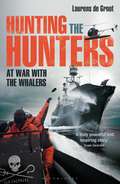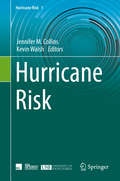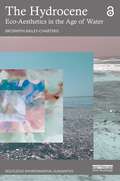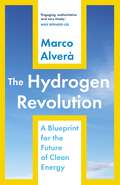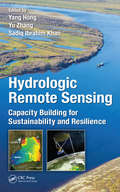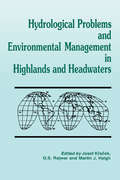- Table View
- List View
Hunting for Frogs on Elston, and Other Tales from Field & Street
by Jerry SullivanA selection of savvy observations on urban ecology from one of the Midwest's foremost authorities on the subject, Hunting for Frogs on Elston collects the best of naturalist Jerry Sullivan's weekly Field & Street columns, originally published in the Chicago Reader. Engaging, opinionated, inspiring, and occasionally irreverent, Hunting for Frogs on Elston pays tribute to Chicago's natural history while celebrating one of its greatest champions. Published in association with the Chicago Wilderness coalition, Hunting for Frogs on Elston comprehensively chronicles Chicagoland's unique urban ecology, from its indigenous prairie and oft-delayed seasons to its urban coyotes and passenger pigeons. In witty, informed prose, Sullivan evokes his adventures netting dog-faced butterflies, hunting rattlesnakes, and watching fireflies mate. Inspired by regional flora and fauna, Sullivan ventures throughout the metropolis and its environs in search of sludge worms, gyrfalcons, and wild onions. In reporting his findings to otherwise oblivious urbanites, Sullivan endeavors to make "alienated, atomized, postmodern people feel at home, connected to something beyond ourselves." In the sprawling Chicagoland region, where an urban ecosystem teeming with remarkable life evolves between skyscrapers and train tracks, no writer chronicled the delicate balance of nature and industry more vividly than Jerry Sullivan. An homage to the urban ecology Sullivan loved so dearly, Hunting for Frogs on Elston is his fitting legacy as well as a lasting gift to the urban naturalist in us all.
Hunting for Frogs on Elston, and Other Tales from Field & Street
by Jerry SullivanA selection of savvy observations on urban ecology from one of the Midwest's foremost authorities on the subject, Hunting for Frogs on Elston collects the best of naturalist Jerry Sullivan's weekly Field & Street columns, originally published in the Chicago Reader. Engaging, opinionated, inspiring, and occasionally irreverent, Hunting for Frogs on Elston pays tribute to Chicago's natural history while celebrating one of its greatest champions. Published in association with the Chicago Wilderness coalition, Hunting for Frogs on Elston comprehensively chronicles Chicagoland's unique urban ecology, from its indigenous prairie and oft-delayed seasons to its urban coyotes and passenger pigeons. In witty, informed prose, Sullivan evokes his adventures netting dog-faced butterflies, hunting rattlesnakes, and watching fireflies mate. Inspired by regional flora and fauna, Sullivan ventures throughout the metropolis and its environs in search of sludge worms, gyrfalcons, and wild onions. In reporting his findings to otherwise oblivious urbanites, Sullivan endeavors to make "alienated, atomized, postmodern people feel at home, connected to something beyond ourselves." In the sprawling Chicagoland region, where an urban ecosystem teeming with remarkable life evolves between skyscrapers and train tracks, no writer chronicled the delicate balance of nature and industry more vividly than Jerry Sullivan. An homage to the urban ecology Sullivan loved so dearly, Hunting for Frogs on Elston is his fitting legacy as well as a lasting gift to the urban naturalist in us all.
Hunting Nature: Ivan Turgenev and the Organic World
by Thomas P. HodgeIn Hunting Nature, Thomas P. Hodge explores Ivan Turgenev's relationship to nature through his conception, description, and practice of hunting—the most unquenchable passion of his life. Informed by an ecocritical perspective, Hodge takes an approach that is equal parts interpretive and documentarian, grounding his observations thoroughly in Russian cultural and linguistic context and a wide range of Turgenev's fiction, poetry, correspondence, and other writings. Included within the book are some of Turgenev's important writings on nature—never previously translated into English. Turgenev, who is traditionally identified as a chronicler of Russia's ideological struggles, is presented in Hunting Nature as an expert naturalist whose intimate knowledge of flora and fauna deeply informed his view of philosophy, politics, and the role of literature in society. Ultimately, Hodge argues that we stand to learn a great deal about Turgenev's thought and complex literary technique when we read him in both cultural and environmental contexts. Hodge details how Turgenev remains mindful of the way textual detail is wedded to the organic world—the priroda that he observed, and ached for, more keenly than perhaps any other Russian writer.
Hunting the Hunters: At War with the Whalers
by Laurens de Groot'As the rest of the world stood by and watched, Laurens risked everything to defend these extraordinary mammals from extinction. A truly powerful and inspiring story.' Susan SarandonLaurens de Groot was a detective for the Dutch police, specializing in organized crime and environmental pollution. He was rapidly promoted through the ranks, but became increasingly disillusioned with failed prosecutions and minimal prison sentences. But although as a detective there was little he could do to stop the truly big criminals, there was a more radical option – direct action, not necessarily within the law. Laurens leaves his job, sells up, travels to Australia and joins Sea Shepherd, an international organization protecting marine wildlife. He soon finds himself in the middle of the war against the Japanese whaling fleet operating in the Antarctic whale sanctuary. As the Japanese hunt whales, Laurens and the Sea Shepherd crews hunt them. Their boats are tiny for the wild Southern Ocean, and as well as dealing with the extreme weather they are repeatedly attacked by the Japanese crews and nearly shipwrecked by ice. On one mission, their boat is rammed, cut in two and sunk by a whaling ship. This is war, with no quarter given. Hunting the Hunters is an action-packed and timely account of one man's extraordinary life, as well as an ongoing battle against a powerful nation determined to get its way no matter the cost. It's an important subject, one that a lot of people care about, and as Laurens tells the story in his own words this is a compelling and insightful book.
Hunting the Hunters: At War with the Whalers
by Laurens De Groot'As the rest of the world stood by and watched, Laurens risked everything to defend these extraordinary mammals from extinction. A truly powerful and inspiring story.' Susan SarandonLaurens de Groot was a detective for the Dutch police, specializing in organized crime and environmental pollution. He was rapidly promoted through the ranks, but became increasingly disillusioned with failed prosecutions and minimal prison sentences. But although as a detective there was little he could do to stop the truly big criminals, there was a more radical option – direct action, not necessarily within the law. Laurens leaves his job, sells up, travels to Australia and joins Sea Shepherd, an international organization protecting marine wildlife. He soon finds himself in the middle of the war against the Japanese whaling fleet operating in the Antarctic whale sanctuary. As the Japanese hunt whales, Laurens and the Sea Shepherd crews hunt them. Their boats are tiny for the wild Southern Ocean, and as well as dealing with the extreme weather they are repeatedly attacked by the Japanese crews and nearly shipwrecked by ice. On one mission, their boat is rammed, cut in two and sunk by a whaling ship. This is war, with no quarter given. Hunting the Hunters is an action-packed and timely account of one man's extraordinary life, as well as an ongoing battle against a powerful nation determined to get its way no matter the cost. It's an important subject, one that a lot of people care about, and as Laurens tells the story in his own words this is a compelling and insightful book.
Hurricane Lizards and Plastic Squid: How the Natural World is Adapting to Climate Change
by Thor Hanson'An original, wide-ranging and carefully researched book ... contains important lessons for humanity.' Mark Cocker, The SpectatorA fascinating insight into climate change biology around the globe, as well as in our own backyards.Hurricane Lizards and Plastic Squid is the first major book by a biologist to focus on the fascinating story of how the natural world is adjusting, adapting, and sometimes measurably evolving in response to climate change. Lyrical and thought-provoking, this book broadens the climate focus from humans to the wider lattice of life.Bestselling nature writer Thor Hanson - author of Buzz (a Radio 4 'Book of the Week') - shows us how Caribbean lizards have grown larger toe pads to grip trees more tightly during frequent hurricanes; and how the 'plasticity' of squid has allowed them to change their body size and breeding habits to cope with altered sea temperatures.Plants and animals have a great deal to teach us about the nature of what comes next, because for many of them, and also for many of us, that world is already here.
Hurricane Risk (Hurricane Risk #1)
by Jennifer M. Collins Kevin WalshThis book details the outcomes of new research focusing on climate risk related to hurricanes. Topics include numerical simulation of tropical cyclones, through tropical cyclone hazard estimation to damage estimates and their implications for commercial risk. Inspired by the 6th International Summit on Hurricanes and Climate Change: From Hazard to Impact, this book brings together leading international academics and researchers, and provides a source reference for both risk managers and climate scientists for research on the interface between tropical cyclones, climate and risk.
Hurricanes and Climate Change: Volume 3
by Jennifer M. Collins Kevin WalshThis book provides research that shows tropical cyclones are more powerful than in the past with the most dramatic increases occurring over the North Atlantic and with the strongest hurricanes. Although such increases are correlated with warming oceans and are consistent with the thermodynamic theory of hurricane intensity, there remains doubt about the interpretation, integrity, and meaning of these results. Arising from the 5th International Summit on Hurricanes and Climate Change, this book contains new research on topics related to hurricanes and climate change. Bringing together international leading academics and researchers on various sides of the debate, the book discusses new research and expresses opinions about what is happening and what might happen in the future with regard to regional and global hurricane (tropical cyclone) activity.
Hütte: Umweltschutztechnik (VDI-Buch)
by Ekkehard WeberDas Handbuch "HÜTTE Umweltschutztechnik" ist ein praxisorientiertes Nachschlagewerk zu den wichtigsten Grundlagen des Umweltschutzes. Experten aus Wissenschaft, Verwaltung und Industrie stellen in kurzer, verständlicher Form ihr Spezialgebiet vor. Neben den technischen Grundlagen des Umweltschutzes wird auch auf administrative und rechtliche Grundlagen sowie ökonomische und medizinische Belange eingegangen. Darüber hinaus werden sicherheits- sowie meß- und analysentechnische Aspekte dargestellt. Das umfasssende Nachschlagewerk gehört auf jeden Schreibtisch von Wissenschaftlern, Studenten und Berufstätigen, die sich im weitesten Sinne mit dem Umweltschutz beschäftigen.
Hydraulic Modeling
by Victor M. Lyatkher Alexander M. ProudovskyWater. Except for air, it is the most important ingredient to all life on Earth. It surrounds us every day. We are literally bathed in it, we cook our food with it, and we need a steady stream of it in our bodies every single day just to survive. But water, and the study of it, is one of the most important and unheralded branches of engineering, affecting every other aspect of engineering in almost every industry. We harness its power for energy, we inject massive blasts of it into the earth to extract oil, gas, and minerals, and we use it in nearly every single industrial application, including food processing, refining, manufacturing, and waste disposal, just to name a few. Hyraulic modeling is, essentially, the understanding and prediction of fluid flow and its applications in industrial, municipal, and environmental settings, whether in a creekbed, locked in the pores of rocks deep in the earth, or in the ocean. Mathematical models, which started out with mechanical pencils and drafting tables originally, have been increasingly relied upon over the last few decades, due to the invention, growth, and refinement of computers. Physical modeling, however, is still practiced in laboratories, and it is the intersection of physical and mathematical modeling of fluid flow that is most successful in creating models that are safer, less costly, and are better for the environment. Hydraulic Modeling introduces and explores this incredibly important science, from the most basic tenets to valuable real-world applications that are used in industry today. It is the only volume on the market to offer a thorough coverage of the subject without adding lots of useless fluff or inapplicable appendices. It is a must-have for any engineer, scientist, or student working with hydraulic modeling, as a daily reference or a textbook.
Hydraulic Modeling
by Victor M. Lyatkher Alexander M. ProudovskyWater. Except for air, it is the most important ingredient to all life on Earth. It surrounds us every day. We are literally bathed in it, we cook our food with it, and we need a steady stream of it in our bodies every single day just to survive. But water, and the study of it, is one of the most important and unheralded branches of engineering, affecting every other aspect of engineering in almost every industry. We harness its power for energy, we inject massive blasts of it into the earth to extract oil, gas, and minerals, and we use it in nearly every single industrial application, including food processing, refining, manufacturing, and waste disposal, just to name a few. Hyraulic modeling is, essentially, the understanding and prediction of fluid flow and its applications in industrial, municipal, and environmental settings, whether in a creekbed, locked in the pores of rocks deep in the earth, or in the ocean. Mathematical models, which started out with mechanical pencils and drafting tables originally, have been increasingly relied upon over the last few decades, due to the invention, growth, and refinement of computers. Physical modeling, however, is still practiced in laboratories, and it is the intersection of physical and mathematical modeling of fluid flow that is most successful in creating models that are safer, less costly, and are better for the environment. Hydraulic Modeling introduces and explores this incredibly important science, from the most basic tenets to valuable real-world applications that are used in industry today. It is the only volume on the market to offer a thorough coverage of the subject without adding lots of useless fluff or inapplicable appendices. It is a must-have for any engineer, scientist, or student working with hydraulic modeling, as a daily reference or a textbook.
Hydro-mechanical Analysis of Rainfall-Induced Landslides
by Lizhou Wu Runqiu Huang Xu LiMost landslides are triggered by rainfall. In previous studies, slope stability is often evaluated based on the infiltration analysis. Hydro-mechanical coupling is significant to rainfall-caused landslide evolution. This book covers theoretical models of unsaturated infiltration, and provides hydro-mechanical models for rainfall-induced landslides. The influences of rainfall patterns, boundary conditions, layered structures, and SWCC hysteresis on the coupled unsaturated infiltration and deformation are discussed. Laboratory testing of rainfall-induced landslides is performed to study the developing process of landslide upon rainfall infiltration. The results provide a better understanding of rainfall-induced landslides.
Hydrocarbon Nation: How Energy Security Made Our Nation Great and Climate Security Will Save Us (The Johns Hopkins University Studies in Historical and Political Science #133)
by Thor HoganIn Hydrocarbon Nation, Thor Hogan looks at how four technological revolutions;¢;‚¬;€?industrial, agricultural, transportation, and electrification;¢;‚¬;€?drew upon the enormous hydrocarbon wealth of the United States, transforming the young country into a nation with unparalleled economic and military potential. Each of these advances engendered new government policies aimed at strengthening national and economic security. The result was unprecedented energy security and the creation of a nation nearly impervious to outside threats. However, when this position weakened in the decades after the peaking of domestic conventional oil supplies in 1970, the American political and economic systems were severely debilitated. At the same time, climate change was becoming a major concern. Fossil fuels created the modern world, yet burning them created a climate crisis. Hogan argues that everyday Americans and policymakers alike must embrace the complexity of this contradiction in order to help society chart a path forward. Doing so, Hogan explains, will allow us to launch a critically important sustainability revolution capable of providing energy and climate security in the future. Hydrocarbon Nation provides reasons to believe that we can succeed in expanding on the benefits of the Hydrocarbon Age in order to build a sustainable future.
Hydrocarbon Nation: How Energy Security Made Our Nation Great and Climate Security Will Save Us (The Johns Hopkins University Studies in Historical and Political Science #133)
by Thor HoganIn Hydrocarbon Nation, Thor Hogan looks at how four technological revolutions;¢;‚¬;€?industrial, agricultural, transportation, and electrification;¢;‚¬;€?drew upon the enormous hydrocarbon wealth of the United States, transforming the young country into a nation with unparalleled economic and military potential. Each of these advances engendered new government policies aimed at strengthening national and economic security. The result was unprecedented energy security and the creation of a nation nearly impervious to outside threats. However, when this position weakened in the decades after the peaking of domestic conventional oil supplies in 1970, the American political and economic systems were severely debilitated. At the same time, climate change was becoming a major concern. Fossil fuels created the modern world, yet burning them created a climate crisis. Hogan argues that everyday Americans and policymakers alike must embrace the complexity of this contradiction in order to help society chart a path forward. Doing so, Hogan explains, will allow us to launch a critically important sustainability revolution capable of providing energy and climate security in the future. Hydrocarbon Nation provides reasons to believe that we can succeed in expanding on the benefits of the Hydrocarbon Age in order to build a sustainable future.
The Hydrocene: Eco-Aesthetics in the Age of Water (ISSN)
by Bronwyn Bailey-CharterisThis book challenges conventional notions of the Anthropocene and champions the Hydrocene: the Age of Water. It presents the Hydrocene as a disruptive, conceptual epoch and curatorial theory, emphasising water's pivotal role in the climate crisis and contemporary art.The Hydrocene is a wet ontological shift in eco-aesthetics which redefines our approach to water, transcending anthropocentric, neo-colonial and environmentally destructive ways of relating to water. As the most fundamental of elements, water has become increasingly politicised, threatened and challenged by the climate crisis. In response, The Hydrocene articulates and embodies the distinctive ways contemporary artists relate and engage with water, offering valuable lessons towards climate action. Through five compelling case studies across swamp, river, ocean, fog and ice, this book binds feminist environmental humanities theories with the practices of eco-visionary artists. Focusing on Nordic and Oceanic water-based artworks, it demonstrates how art can disrupt established human–water dynamics. By engaging hydrofeminist, care-based and planetary thinking, The Hydrocene learns from the knowledge and agency of water itself within the tide of art going into the blue.The Hydrocene urgently highlights the transformative power of eco-visionary artists in reshaping human–water relations. At the confluence of contemporary art, curatorial theory, climate concerns and environmental humanities, this book is essential reading for researchers, curators, artists, students and those seeking to reconsider their connection with water and advocate for climate justice amid the ongoing natural-cultural water crisis.The Open Access version of this book, available at http://www.taylorfrancis.com, has been made available under a Creative Commons Attribution-Non Commercial-No Derivatives (CC-BY-NC-ND) 4.0 license.
The Hydrocene: Eco-Aesthetics in the Age of Water (ISSN)
by Bronwyn Bailey-CharterisThis book challenges conventional notions of the Anthropocene and champions the Hydrocene: the Age of Water. It presents the Hydrocene as a disruptive, conceptual epoch and curatorial theory, emphasising water's pivotal role in the climate crisis and contemporary art.The Hydrocene is a wet ontological shift in eco-aesthetics which redefines our approach to water, transcending anthropocentric, neo-colonial and environmentally destructive ways of relating to water. As the most fundamental of elements, water has become increasingly politicised, threatened and challenged by the climate crisis. In response, The Hydrocene articulates and embodies the distinctive ways contemporary artists relate and engage with water, offering valuable lessons towards climate action. Through five compelling case studies across swamp, river, ocean, fog and ice, this book binds feminist environmental humanities theories with the practices of eco-visionary artists. Focusing on Nordic and Oceanic water-based artworks, it demonstrates how art can disrupt established human–water dynamics. By engaging hydrofeminist, care-based and planetary thinking, The Hydrocene learns from the knowledge and agency of water itself within the tide of art going into the blue.The Hydrocene urgently highlights the transformative power of eco-visionary artists in reshaping human–water relations. At the confluence of contemporary art, curatorial theory, climate concerns and environmental humanities, this book is essential reading for researchers, curators, artists, students and those seeking to reconsider their connection with water and advocate for climate justice amid the ongoing natural-cultural water crisis.The Open Access version of this book, available at http://www.taylorfrancis.com, has been made available under a Creative Commons Attribution-Non Commercial-No Derivatives (CC-BY-NC-ND) 4.0 license.
The Hydrogen Revolution: a blueprint for the future of clean energy
by Marco Alverà'Engaging, authoritative and very timely. Marco Alverà spells Hydrogen's critical role as an energy store in the clean power transition' - Mike Berners-Lee, author of THERE IS NO PLANET BPicture this: It's 2050. The looming shadow of climate change is finally receding. The planet's temperature is stabilising. Rainforests and coral reefs beginning to thrive once more. We are returning to equilibrium with nature. This isn't wishful thinking; it can be our reality. We just need to embrace hydrogen: the missing link.The beauty of hydrogen is its simplicity. It's simple to make, and simple to use. You are essentially bottling sunlight from renewable energy sources in the form of hydrogen, and using it to bring clean energy to every corner of the globe. The best part about hydrogen is that when you use it, the only by-product is water.As energy expert Marco Alverà explains, if we're going to heal the climate, we need to start thinking big. This book is the blueprint for how to get us there. Whether you are a policy maker, a business person, an activist, or simply curious, the message is this: there is hope, for us and our planet. Hydrogen can help save the world.
Hydrogeologische Untersuchungsmethoden von Altlasten
by Winfried EntenmannBei Deponien, die im Verdacht stehen, das Grundwasser zu gefährden, müssen Gefährdungsabschätzungen durchgeführt werden. Sie sind entscheidend bei der Frage, ob eine Sanierung nötig ist. Die Gefährdungsabschätzung ist auch Grundlage für den Grundwasserbeweissicherungsplan, der zur dauerhaften Überwachung der Altlast aufgestellt wird. Langjährige praktische Arbeiten bei der Gefährdungsabschätzung, Beweissicherung und bei sanierungsbegleitenden Untersuchungen zeigen, daß die Methoden der klassischen Hydrogeologie, die für Untersuchungen zur Grundwassererschließung entwickelt wurden, für den Grundwasserschutz nicht ausreichend sind. Dieses Buch stellt deshalb Methoden der Erkundung, Auswertung und Bewertung hydrogeologischer Methoden vor, die im Zuge der Arbeiten an Altlasten und Deponien entwickelt wurden.
Hydrologic Remote Sensing: Capacity Building for Sustainability and Resilience
by Yang Hong Yu Zhang Sadiq Ibrahim KhanEnvironmental remote sensing plays a critical role in observing key hydrological components such as precipitation, soil moisture, evapotranspiration and total water storage on a global scale. As water security is one of the most critical issues in the world, satellite remote sensing techniques are of particular importance for emerging regions which have inadequate in-situ gauge observations. This book reviews multiple remote sensing observations, the application of remote sensing in hydrological modeling, data assimilation and hydrological capacity building in emerging regions.
Hydrologic Remote Sensing: Capacity Building for Sustainability and Resilience
by Yu Zhang Yang Hong Sadiq Ibrahim KhanEnvironmental remote sensing plays a critical role in observing key hydrological components such as precipitation, soil moisture, evapotranspiration and total water storage on a global scale. As water security is one of the most critical issues in the world, satellite remote sensing techniques are of particular importance for emerging regions which have inadequate in-situ gauge observations. This book reviews multiple remote sensing observations, the application of remote sensing in hydrological modeling, data assimilation and hydrological capacity building in emerging regions.
Hydrological and Biological Responses to Forest Practices: The Alsea Watershed Study (Ecological Studies #199)
by John D. StednickThe Alsea Logging and Aquatic Resources Study, commissioned by the Oregon Legislature in 1959, marked the beginning of four decades of research in the Pacific Northwest devoted to understanding the impacts of forest practices on water quality, water quantity, aquatic habitat, and aquatic organism popu- tions. While earlier watershed research examined changes in runoff and erosion from various land uses, this study was the first watershed experiment to focus so heavily on aquatic habitat and organism response to forest practices. The Alsea Watershed Study, as it came to be known, extended over 15 years with seven years of pretreatment calibration measurements, a year of treatment, and seven years of post-treatment monitoring. The research was a cooperative effort with scientists from Oregon State University, Oregon Department of Fish and Wildlife, the U.S. Geological Survey, and the U.S. Environmental Protection Agency. Cooperating landowners included the Georgia-Pacific Corporation, the U.S. Forest Service, and a local rancher. It was a remarkable 15-year partnership marked by excellent cooperation among the participants and outstanding coordination among the scientists, many of whom participated actively for the entire period.
Hydrological Problems and Environmental Management in Highlands and Headwaters
by Martin HaighThis set of papers presents a description of the synthesis of hydrological problems and various environmental implications and management strategies for different highland and headwater regions of the world. Regions covered include the Himalayas, Russian mountains, Amazonia, and upland Wales.
Hydrological Problems and Environmental Management in Highlands and Headwaters
by Josef Křeček G. S. Rajwar Martin J. HaighThis set of papers presents a description of the synthesis of hydrological problems and various environmental implications and management strategies for different highland and headwater regions of the world. Regions covered include the Himalayas, Russian mountains, Amazonia, and upland Wales.
Hydrological, Socioeconomic and Ecological Impacts of the North Atlantic Oscillation in the Mediterranean Region (Advances in Global Change Research #46)
by Sergio M. Vicente-Serrano and Ricardo M. TrigoThe Mediterranean basin represents one of the most important “hot spots” of climate change in the world, with recent trends towards a hotter and drier climate being related to changes in atmospheric circulation patterns. Such changes can have significant impacts in the climate of this region but also on the natural environment and several socioeconomic activities. Among these patterns, the North Atlantic Oscillation (NAO) is one of the main forcing factors in the region with impact on extreme events such as droughts, severe precipitations or heat and cold waves, the availability of water resources, the ecological dynamics, the quality and quantity of crops, the migration and welfare of animal populations, the fisheries dynamics, the triggering of landslides and the air pollution and human health, among others. The aim of Hydrological, Socioeconomic and Ecological Impacts of the North Atlantic Oscillation in the Mediterranean Region, is to serve as an updated reference text that covers the wide range of evidences on the NAO impacts in the Mediterranean regions and from a multidisciplinary perspective. This volume constitutes a unique document to present the state of the art of the numerous studies undertaken on the hydrological, socioeconomic and ecological impact of the NAO, collecting the expertise of researchers from several complementary earth science fields (geography, hydrology, remote-sensing, climatology, agriculture, energy), but that have been lacking a common ground.
Hydrology: A Science for Engineers
by André Musy Benoit Hingray Cécile PicouetThis book presents the main hydrological methods and techniques used in the design and operation of hydraulic projects and the management of water resources and associated natural risks. It covers the key topics of water resources engineering, from the estimation of runoff volumes and unit hydrographs to the routing of flows along a river and throu


